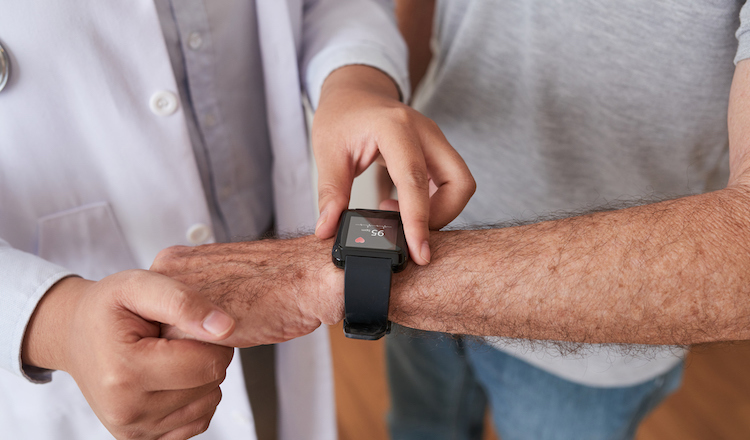
The latest wearable medical devices are transforming clinical research processes and outcomes by enabling clinicians to collect a wealth of data remotely. Such advances are saving time, saving money, and increasing access to clinical trials for a much broader group of people than before.
The COVID-19 pandemic prompted health care providers and researchers to find new ways to communicate with patients during mandatory shutdowns, such as through telehealth visits and wearable devices to capture data; however, most health care facilities are now fully reopened for business as usual. Yet the reliance on small wearable devices has continued to expand, which can be especially valuable for those in the clinical research field.
“Wearables make it much more accessible than ever to get biological measurements from people during a study,” explains Jamie Robertson, PhD, MPH, Director of Innovation in Surgical Education at Brigham and Women’s Hospital and Program Co-Director of Harvard Medical School’s Post-Graduate Medical Education program, Foundations of Clinical Research.
Wearables: Providing More Convenient Ways to Track Patient Data
In fact, thanks to advances in technology, the newest crop of wearable devices is optimized to capture a variety of distinct patient health indicators that can provide a clear snapshot of a person’s health status during their everyday activities in a more detailed way than in-person measurements typically can provide. The types of indicators wearable devices capture include everything from tracking activity levels to measuring sleep quality and quantity, to assessing heart rate and other vital signs—all in real-life settings and circumstances. This enables researchers to understand a patient’s physical status over a longer period than usually can be accomplished during a health care visit.
“We used to have to hook people up to expensive machinery [to monitor heart function],” Robertson says. “Today, we have lots of effective heart rate–monitoring options [via wearables] that are easy to use and noninvasive [for patients to use themselves],” she adds. For instance, a person undergoing heart rate monitoring can wear a device and collect data while they go about the course of their regular day in their own environment. This not only provides increased convenience, such as by allowing the participant to work while contributing to the research, but it also provides a realistic look at how a person’s heart rate responds to the stresses of their workday or home life.
Wearables Facilitate Broader Clinical Trial Participation
By enabling the monitoring to be done from home, wearables can also make it much easier for people to participate in studies, especially since they don’t have to miss work, hire a babysitter, or travel long distances to take part. Better yet, while traditional medical equipment can be cumbersome or overwhelming to use, most wearables are comfortable and familiar.
“A lot of people in the U.S. already have some type of smart watch and are tracking some data,” Robertson points out. While some of the data that smart watches and fitness trackers collect, are not formally sanctioned by the medical community, the results gathered can paint a clear picture of a person’s health status and alert them to problems when something is wrong.
For the purposes of research studies, often the sponsor will provide a device that is more accurate to ensure the quality of the data collected. But the concept is the same and most people don’t feel intimidated using this type of wearable technology.
Empowering Patients with Wearables Data
Beyond tracking details in the name of medical research or patient monitoring, there are lots of other insights patients can glean for themselves using a smart watch or other fitness tracking device.
“Even if people aren’t participating in a clinical trial, they have data about their health right on their wrist, and it can alert them to potential issues,” Robertson explains. She stresses that while wearables can’t take the place of a doctor, they can identify important health trends, such as a steep increase in the resting heart rate, and can provide enough information for people to talk to their doctor about the problem in order to explore it further and rule out or confirm any serious medical problem that may arise.
Another example of how wearables can improve the patient experience and/or lead to better outcomes is using them to assess possible sleep apnea. In fact, a growing number of people are able to use wearable medical devices to take the place of participating in a sleep lab study. The lab can mail a device to a patient, which allows them to track their sleep from the comfort of their own bed while following their typical sleep habits.
“The data collected will more accurately show how people behave in their own environment and in their own beds,” Robertson says.
Using Wearables to Expand Access to Care
Wearables can also increase access to care in some cases. For instance, clinicians can send out wearable devices to people who live in more rural parts of the country where they may have to travel long distances to access specialty care; this can make it possible to not only collect data, but also to share key data with clinicians in other locations, thus improving access to high-quality care.
By making it easier for people with various circumstances and needs to participate in clinical trials and access care, the latest wearables can help accelerate the development and approval of new treatments for a host of conditions, while also attracting a broader range of study participants.
Looking to the Future of Wearable Medical Devices
“I think this trend of using wearables to contribute to research will continue to grow,” Robertson says. “For clinical research purposes, this opens up a door for researchers to collect data from people they didn’t have access to in the past. This provides them with a more representative sample size and hopefully allows them to get a wider range of people from broader geographical regions they couldn’t attract before,” she says. This expanded reach can be helpful to recruit people from different races, different ethnic backgrounds, and different socioeconomic levels—and with different sexual and gender identities—helping to address some of the disparities in clinical trial participation that currently exists.
Further, one important improvement in wearables is on the horizon will create faster—and easier—ways to transfer data from the devices directly to clinicians without any risk of patient privacy. This will make it quicker and safer to share analytics, adding: “It’s really amazing how far the latest technologies have come [in advancing wearable medical devices], and what they can allow us to accomplish today.”


